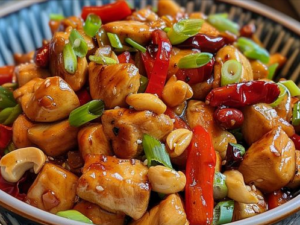
Here are 20 popular questions and their answers related to Spicy Kung Pao Chicken Stir-Fry:
- What is Kung Pao Chicken?
- Kung Pao Chicken is a popular Chinese stir-fry dish featuring tender chicken, peanuts, and vegetables in a spicy and tangy sauce.
- Is Kung Pao Chicken spicy?
- Yes, Kung Pao Chicken is typically spicy due to the use of chili garlic paste or dried red chilies in the sauce. The level of spiciness can be adjusted based on personal preference.
- What are the key ingredients in Kung Pao Chicken?
- Key ingredients include chicken (usually breast meat), peanuts or cashews, vegetables (like bell peppers and green onions), garlic, ginger, soy sauce, rice wine vinegar, sesame oil, and chili paste or dried red chilies.
- How do you make Kung Pao Chicken less spicy?
- To make it less spicy, reduce the amount of chili garlic paste or dried red chilies used in the recipe. You can also deseed the chilies before adding them to the dish.
- What vegetables can be used in Kung Pao Chicken?
- Common vegetables used include bell peppers (red, green, or yellow), snow peas, carrots, broccoli, and zucchini. These vegetables add color, texture, and flavor to the dish.
- Can I use other meats besides chicken in Kung Pao stir-fry?
- Yes, you can substitute chicken with other proteins such as shrimp, beef, pork, or tofu to create variations of the dish.
- How do you thicken Kung Pao Chicken sauce?
- To thicken the sauce, create a slurry by mixing cornstarch with water (about 1 tablespoon cornstarch to 2 tablespoons water). Stir this mixture into the simmering sauce until it thickens to your desired consistency.
- What kind of rice is best with Kung Pao Chicken?
- Jasmine rice or long-grain white rice are popular choices to serve with Kung Pao Chicken. The fragrant jasmine rice complements the bold flavors of the dish.
- Is Kung Pao Chicken gluten-free?
- It can be made gluten-free by using gluten-free soy sauce and ensuring all other ingredients, such as vinegar and chili paste, are also gluten-free. Check labels to be sure.
- How do you pronounce “Kung Pao”?
- It is pronounced as “kung pow” in English.
- Is Kung Pao Chicken healthy?
- Kung Pao Chicken can be part of a balanced diet when prepared with lean chicken breast, lots of vegetables, and moderate amounts of sauce. Using less oil and sodium can also make it healthier.
- Can Kung Pao Chicken be made ahead of time?
- While it’s best served fresh, you can prepare the sauce and marinate the chicken ahead of time. Stir-fry the chicken and vegetables just before serving to maintain their texture.
- How long should you marinate chicken for Kung Pao Chicken?
- Marinate chicken pieces for at least 30 minutes, or up to 1 hour, in a mixture of soy sauce, sesame oil, and cornstarch. This helps tenderize the meat and infuse it with flavor.
- Can you freeze Kung Pao Chicken?
- It’s not recommended to freeze Kung Pao Chicken as the texture of the vegetables and chicken may change upon thawing. It’s best enjoyed fresh.
- What makes Kung Pao Chicken different from General Tso’s Chicken?
- Kung Pao Chicken is typically spicier and has a tangy flavor due to the use of chili paste and rice vinegar. General Tso’s Chicken is sweeter and often has a thicker, more caramelized sauce.
- Can I make Kung Pao Chicken without peanuts?
- Yes, you can omit peanuts if you have allergies or prefer not to use them. Substitute with cashews or simply leave them out.
- What is the difference between Kung Pao Chicken and Szechuan Chicken?
- Kung Pao Chicken is a specific dish known for its spicy and tangy flavors with peanuts, while Szechuan Chicken (or Sichuan Chicken) refers to a broader style of cooking from the Sichuan province of China, known for its bold, spicy flavors using Szechuan peppercorns and chili peppers.
- How do you prevent chicken from becoming tough in Kung Pao Chicken?
- Velveting the chicken (briefly blanching in hot water or broth) before stir-frying helps keep it tender. Stir-fry over high heat for a short time to avoid overcooking.
- What is the best oil for stir-frying Kung Pao Chicken?
- Use oils with a high smoke point such as peanut oil, vegetable oil, or canola oil for stir-frying. Sesame oil is added for flavor but should not be used as the primary cooking oil due to its lower smoke point.
- How do you adjust the spiciness of Kung Pao Chicken?
- To make it milder, reduce the amount of chili paste or dried red chilies. For extra spice, add more chili paste or use hotter varieties of chili peppers.
These answers should help clarify common questions about Spicy Kung Pao Chicken Stir-Fry, making it easier to prepare and enjoy this delicious dish at home.
